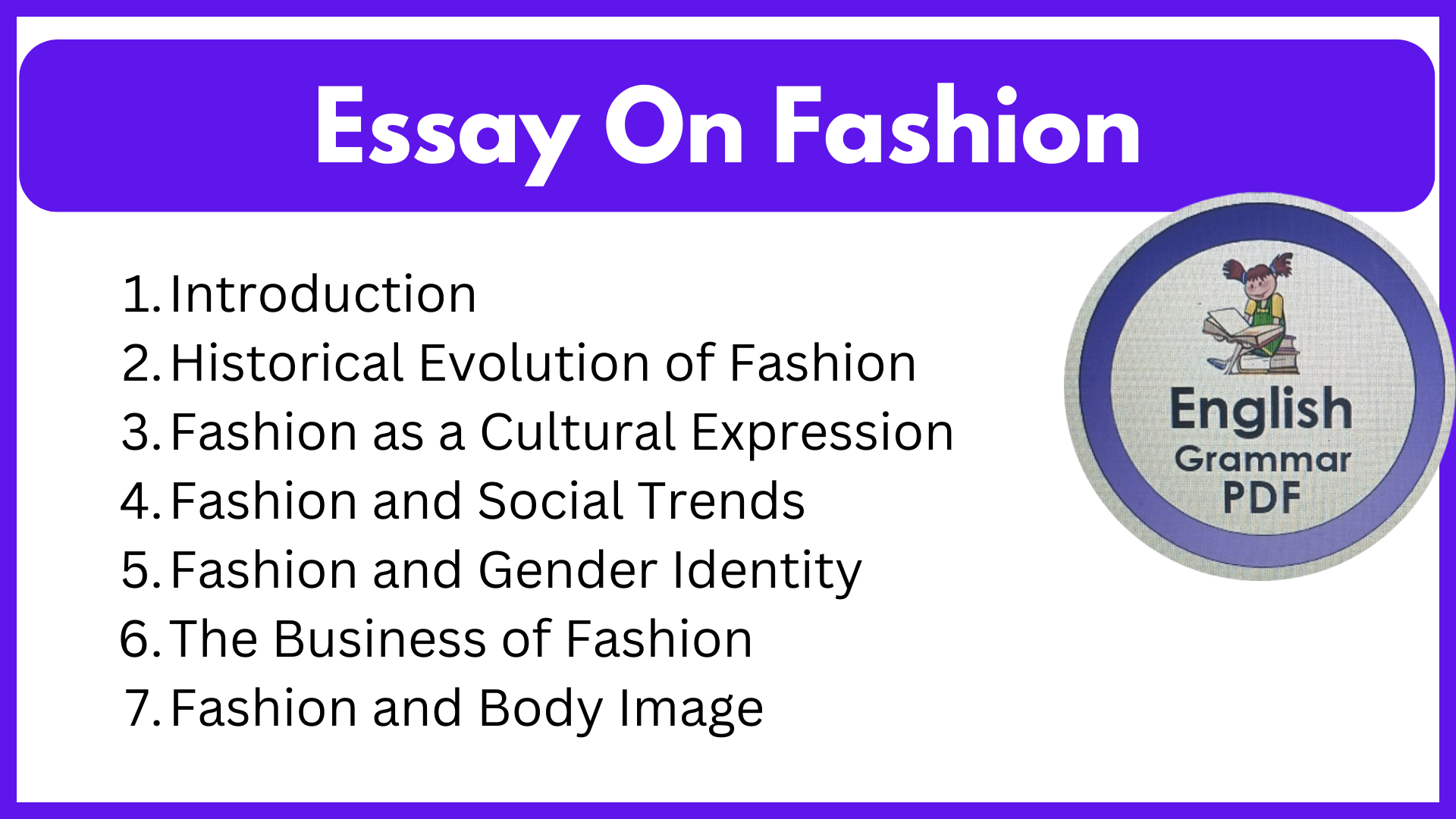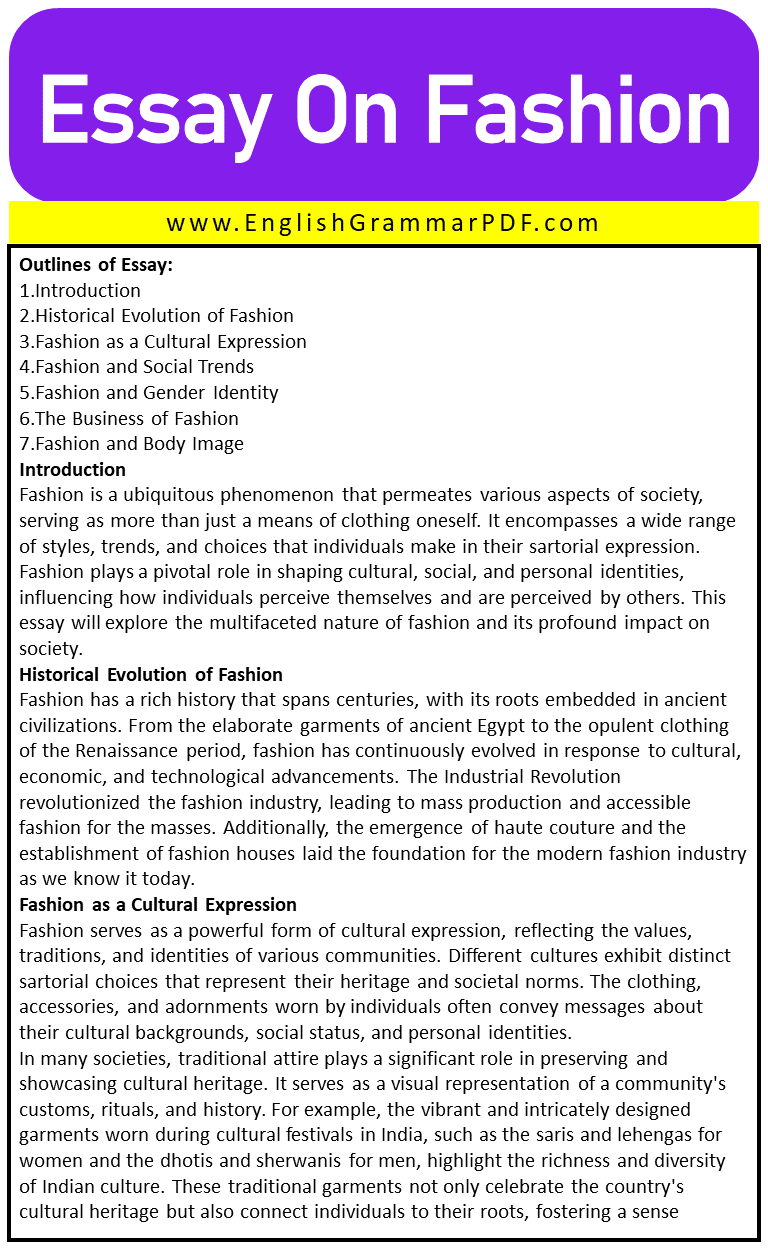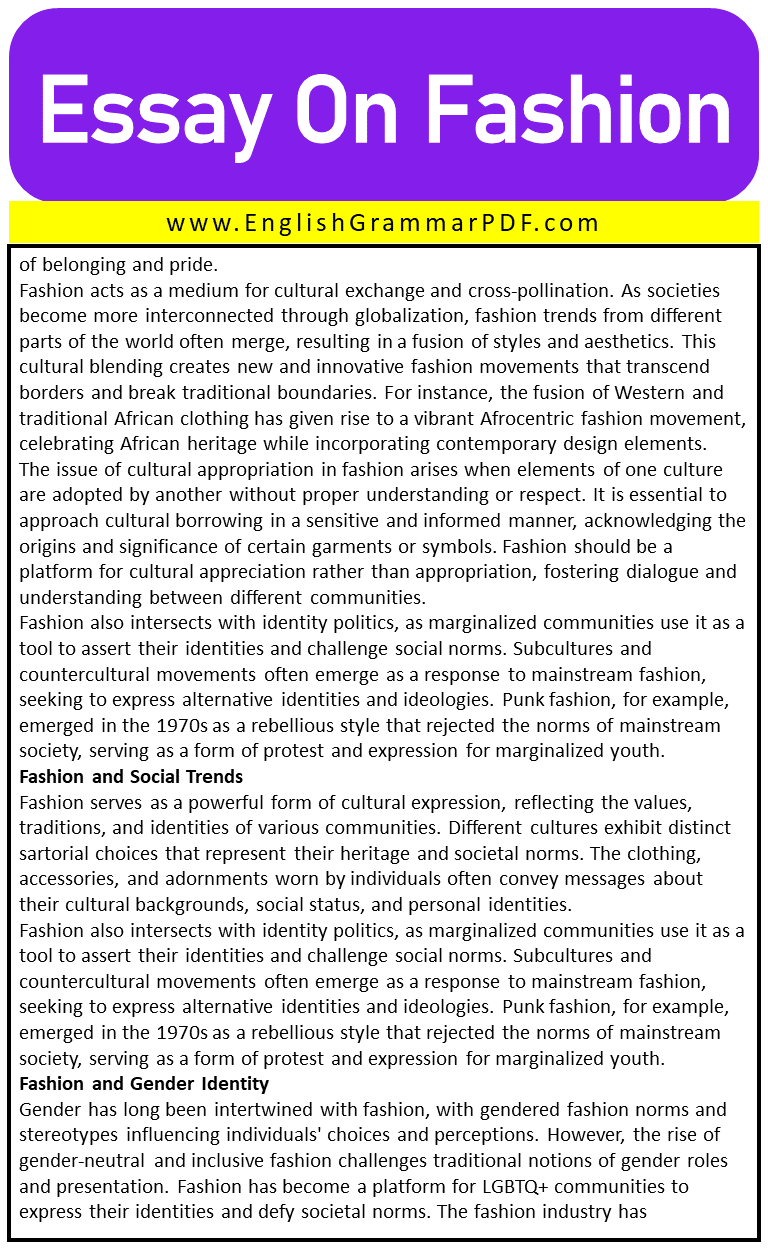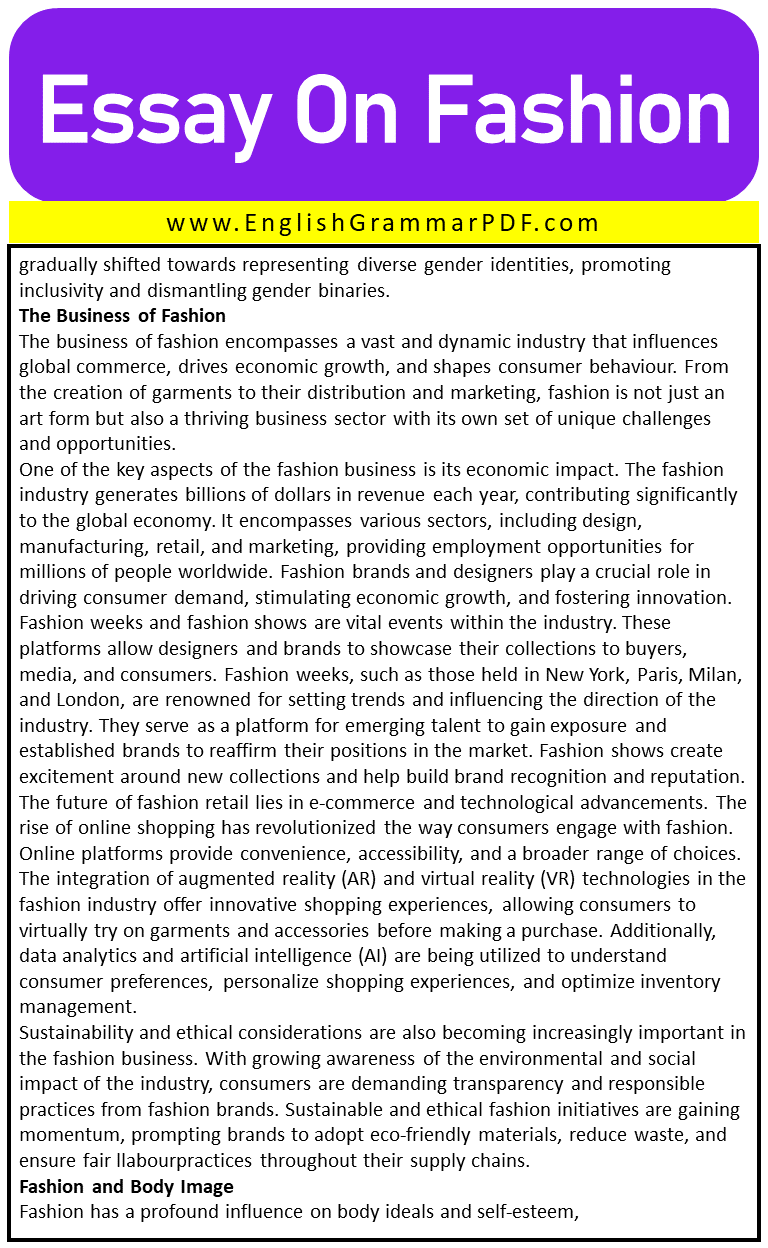Essay On Fashion
Outlines of Essay:
- Introduction
- Historical Evolution of Fashion
- Fashion as a Cultural Expression
- Fashion and Social Trends
- Fashion and Gender Identity
- The Business of Fashion
- Fashion and Body Image
Introduction
Fashion is a ubiquitous phenomenon that permeates various aspects of society, serving as more than just a means of clothing oneself. It encompasses a wide range of styles, trends, and choices that individuals make in their sartorial expression. Fashion plays a pivotal role in shaping cultural, social, and personal identities, influencing how individuals perceive themselves and are perceived by others. This essay will explore the multifaceted nature of fashion and its profound impact on society.
Historical Evolution of Fashion
Fashion has a rich history that spans centuries, with its roots embedded in ancient civilizations. From the elaborate garments of ancient Egypt to the opulent clothing of the Renaissance period, fashion has continuously evolved in response to cultural, economic, and technological advancements. The Industrial Revolution revolutionized the fashion industry, leading to mass production and accessible fashion for the masses. Additionally, the emergence of haute couture and the establishment of fashion houses laid the foundation for the modern fashion industry as we know it today.
Fashion as a Cultural Expression
Fashion serves as a powerful form of cultural expression, reflecting the values, traditions, and identities of various communities. Different cultures exhibit distinct sartorial choices that represent their heritage and societal norms. The clothing, accessories, and adornments worn by individuals often convey messages about their cultural backgrounds, social status, and personal identities.
In many societies, traditional attire plays a significant role in preserving and showcasing cultural heritage. It serves as a visual representation of a community’s customs, rituals, and history. For example, the vibrant and intricately designed garments worn during cultural festivals in India, such as the saris and lehengas for women and the dhotis and sherwanis for men, highlight the richness and diversity of Indian culture. These traditional garments not only celebrate the country’s cultural heritage but also connect individuals to their roots, fostering a sense of belonging and pride.
Fashion acts as a medium for cultural exchange and cross-pollination. As societies become more interconnected through globalization, fashion trends from different parts of the world often merge, resulting in a fusion of styles and aesthetics. This cultural blending creates new and innovative fashion movements that transcend borders and break traditional boundaries. For instance, the fusion of Western and traditional African clothing has given rise to a vibrant Afrocentric fashion movement, celebrating African heritage while incorporating contemporary design elements.
The issue of cultural appropriation in fashion arises when elements of one culture are adopted by another without proper understanding or respect. It is essential to approach cultural borrowing in a sensitive and informed manner, acknowledging the origins and significance of certain garments or symbols. Fashion should be a platform for cultural appreciation rather than appropriation, fostering dialogue and understanding between different communities.
Fashion also intersects with identity politics, as marginalized communities use it as a tool to assert their identities and challenge social norms. Subcultures and countercultural movements often emerge as a response to mainstream fashion, seeking to express alternative identities and ideologies. Punk fashion, for example, emerged in the 1970s as a rebellious style that rejected the norms of mainstream society, serving as a form of protest and expression for marginalized youth.
Fashion and Social Trends
Fashion serves as a powerful form of cultural expression, reflecting the values, traditions, and identities of various communities. Different cultures exhibit distinct sartorial choices that represent their heritage and societal norms. The clothing, accessories, and adornments worn by individuals often convey messages about their cultural backgrounds, social status, and personal identities.
Fashion also intersects with identity politics, as marginalized communities use it as a tool to assert their identities and challenge social norms. Subcultures and countercultural movements often emerge as a response to mainstream fashion, seeking to express alternative identities and ideologies. Punk fashion, for example, emerged in the 1970s as a rebellious style that rejected the norms of mainstream society, serving as a form of protest and expression for marginalized youth.
Fashion and Gender Identity
Gender has long been intertwined with fashion, with gendered fashion norms and stereotypes influencing individuals’ choices and perceptions. However, the rise of gender-neutral and inclusive fashion challenges traditional notions of gender roles and presentation. Fashion has become a platform for LGBTQ+ communities to express their identities and defy societal norms. The fashion industry has gradually shifted towards representing diverse gender identities, promoting inclusivity and dismantling gender binaries.
The Business of Fashion
The business of fashion encompasses a vast and dynamic industry that influences global commerce, drives economic growth, and shapes consumer behaviour. From the creation of garments to their distribution and marketing, fashion is not just an art form but also a thriving business sector with its own set of unique challenges and opportunities.
One of the key aspects of the fashion business is its economic impact. The fashion industry generates billions of dollars in revenue each year, contributing significantly to the global economy. It encompasses various sectors, including design, manufacturing, retail, and marketing, providing employment opportunities for millions of people worldwide. Fashion brands and designers play a crucial role in driving consumer demand, stimulating economic growth, and fostering innovation.
Fashion weeks and fashion shows are vital events within the industry. These platforms allow designers and brands to showcase their collections to buyers, media, and consumers. Fashion weeks, such as those held in New York, Paris, Milan, and London, are renowned for setting trends and influencing the direction of the industry. They serve as a platform for emerging talent to gain exposure and established brands to reaffirm their positions in the market. Fashion shows create excitement around new collections and help build brand recognition and reputation.
The future of fashion retail lies in e-commerce and technological advancements. The rise of online shopping has revolutionized the way consumers engage with fashion. Online platforms provide convenience, accessibility, and a broader range of choices. The integration of augmented reality (AR) and virtual reality (VR) technologies in the fashion industry offer innovative shopping experiences, allowing consumers to virtually try on garments and accessories before making a purchase. Additionally, data analytics and artificial intelligence (AI) are being utilized to understand consumer preferences, personalize shopping experiences, and optimize inventory management.
Sustainability and ethical considerations are also becoming increasingly important in the fashion business. With growing awareness of the environmental and social impact of the industry, consumers are demanding transparency and responsible practices from fashion brands. Sustainable and ethical fashion initiatives are gaining momentum, prompting brands to adopt eco-friendly materials, reduce waste, and ensure fair llabourpractices throughout their supply chains.
Fashion and Body Image
Fashion has a profound influence on body ideals and self-esteem, often perpetuating unrealistic beauty standards. However, there has been a growing movement towards body positivity and inclusivity in the fashion industry. Various campaigns and initiatives aim to challenge narrow beauty ideals and celebrate diverse body types and sizes. Fashion can play a pivotal role in promoting body acceptance and fostering a healthier relationship with one’s body.
FAQ’s
What is fashion in our life?
Fashion keeps society lively through different new styles and subsequent changes. Fashion promotes social changes from time to time and also respects traditions and customs in society. Fashion encourages to modify or amend all those customs that are rigid and have no relevance anymore.
What is the main idea of fashion?
Fashion refers to the idea of what is popular or on trend. One can also think about fashion as what is in flux at a particular time and place. Fashion undergoes a process of dynamic change: within a fashion system, there is a continuous change in what is on trend, or in fashion, over time.
Explore More Essays:
450 Words Music Influence On Society Essay
Download the PDF of the Essay:






